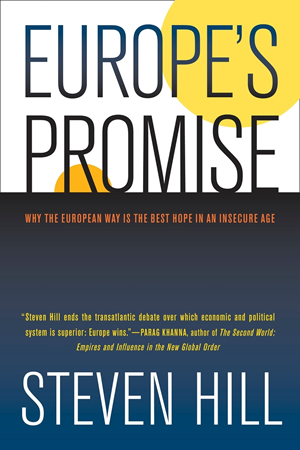
Electoral Reform
916-455-8021


|
Californians for Electoral Reform |
PO Box 128, Sacramento, CA 95812 916-455-8021 
|
| Home | About CfER | Join / renew | Learn | Legislation | Local Campaigns | Community Outreach | Search | ||
|
Voice for Democracy Newsletter of Californians for Electoral Reform Summer 2010 |
Representative Democracy, Version 2.0By Steven Hill Editor's note: This article is based on an excerpt from the author's latest book, Europe's Promise: Why the European Way is the Best Hope in an Insecure Age. I recall the first time I visited the German Bundestag. What was even more memorable than the parliamentary building itself was the legislative chamber. When you visit the chamber of the U.S. House of Representatives, left and right are plain to see – Democrats on one side, Republicans on the other – with an aisle, a dividing line, down the middle, adversaries forever battering each other. With only two viable electoral choices, the free marketplace has spread everywhere except to our politics. But in Germany's Bundestag, I observed five aisles and sections, a different one for each political party. I had always known that Germany is a multi-iparty democracy rather than a two-party democracy, but seeing a visual display of that was a thrill – that's what democracy looks like, I remember thinking. And it also provided a shocking reminder of how lacking in representation the U.S. House – known as "the People's House" – actually is. Indeed, the People's House doesn't look very much like "the people," since those who fill the chairs are 83% white and 83% male in a country that is 67% white and majority female. Also, three-fourths of the seats are filled by lawyers and businessmen, with a plurality of millionaires and the average age being fifty-seven. The Speaker of the House is a woman, but on the whole the People's House still hardly looks or thinks like the American people, and the Senate is even worse in this regard. Two hundred years into our history the U.S. Congress more closely resembles the ancient Roman Senate than a New England town meeting. But in the Bundestag today, six political parties are represented. The Social Democrats and the Christian Democrats are the two main parties, one center-left and the other center-right; they are joined by the Green Party, the Free Democratic Party, the Christian Social Union, and the Left Party, a broad spectrum of opinion occupying the chairs of the national legislature. In addition to this broad representation, 32% of Germany's national representatives are women (nearly twice as many as in the U.S. Congress), including the country's first ever female head of government. A handful of Turkish-descended parliamentarians sit with their peers, the average age of representatives is forty-nine, and even a nineteen-year-old was elected in recent years on the strength of votes from young Germans. These representatives from broad backgrounds, experiences, and political perspectives come together to legislate a nationwide consensus. Compare that with the U.S. Congress. It's pretty hard for a nation as diverse as the U.S. to reach a consensus on the pressing issues of our times when so much of the nation is not seated at the table of power. 
Rather than helping to formulate a national consensus, the winner-take-all electoral system exaggerates the adversarial nature of American politics. With one side dominating whole regions and states, political monocultures have resulted where debate and discussion of innovative ideas have virtually ceased, leaving the two sides bunkered in their polarized regions like combatants in a political and cultural war that has become increasingly bitter. Without a multiparty democracy in which all significant points of view are represented, political debate in the United States has become stunted along increasingly narrow lines in which the best interests of the vast majority of the American people are poorly represented. Why does Europe enjoy multiparty democracy while the U.S. does not? Europe uses different political institutions than America, including proportional representation electoral systems, public financing of campaigns, free media time for candidates and parties, universal voter registration and robust, well-funded public broadcasting that counter-balances the corporate media. The U.S. has little of these, instead relying on institutions that mostly are still rooted in their 18th century origins. In the modern era, this "winner-take-all" system has produced a stark landscape of legislative districts – indeed, entire states – that are little more than one-party fiefdoms. As a result, unequal treatment based on where one lives is a recurring theme in America's antiquated political system, playing out in numerous ways that will continue to undermine majority rule and consensus formation in a nation as diverse as the United States. The group that has had unimpressive political representation in Europe has been ethnic/racial minorities. But as their populations have increased, they have begun making electoral gains by winning representation in federal and state parliaments in various countries. While America has elected a lot more minority representatives than European nations, the 17% of House members and 5% of Senators that are racial/ethnic minority are for a national population that is one-third minority. Europe's ethnic/racial minority populations are much smaller, around 10% or less. While at first glance the United States seems to be a much better example of fairer multiracial representation, American minorities receive only about half the representation they deserve, based on their percentage of the population. In actual practice the U.S. has nearly as large a gap in the ratio of ethnic/racial representatives to population as the gaps in most European democracies. In most ways, European democracies are better equipped to foster broad consensus among diverse populations, stakeholders and interests about the looming challenges of the 21st century. Steven Hill is also the author of Fixing Elections (2002) and 10 Step to Repair American Democracy (2006). He is the former director of the Political Reform Program at the New America Foundation. |
|
To join CfER, or renew your membership, please visit |